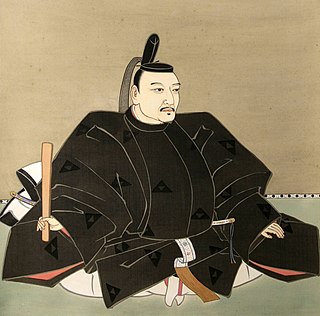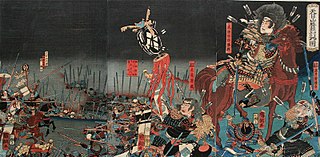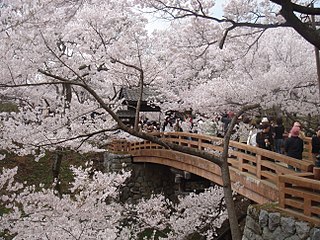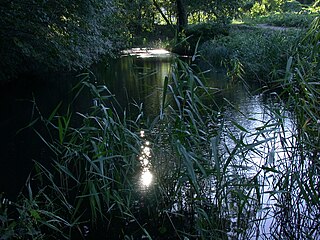
Oda Nobunaga was a Japanese daimyō and one of the leading figures of the Sengoku and Azuchi-Momoyama periods. He was the Tenka-bito and regarded as the first "Great Unifier" of Japan. He is sometimes referred as the "Demon Daimyō" and "Demon King of the Sixth Heaven".

The Azuchi–Momoyama period was the final phase of the Sengoku period in Japanese history from 1568 to 1600.

Takeda Shingen was daimyo of Kai Province during the Sengoku period of Japan. Known as "the Tiger of Kai", he was one of the most powerful daimyo of the late Sengoku period, and credited with exceptional military prestige. Shingen was based in a poor area with little arable land and no access to the sea, but he became one of Japan's leading daimyo. His skills are highly esteemed and on par with Mōri Motonari.

Akiyama Nobutomo was a samurai during the Sengoku period in Japan. He is known as one of the "Twenty-Four Generals of Takeda Shingen". Nobutomo also served under Shingen's son, Takeda Katsuyori.

The Battle of Mikatagahara took place during the Sengoku period of Japan between Takeda Shingen and Tokugawa Ieyasu in Mikatagahara, Tōtōmi Province on 25 January 1573. Shingen attacked Ieyasu at the plain of Mikatagahara north of Hamamatsu during his campaign against Oda Nobunaga while seeking a route from Kōfu to Kyoto. The Tokugawa-Oda force was almost totally annihilated by the Takeda after being encircled and many of Ieyasu's retainers were killed in the battle. Ieyasu and his surviving men were forced to retreat before launching a minor counterattack to delay Shingen's march towards Kyoto.

The Battle of Nagashino was a famous battle in Japanese history, fought in 1575 at Nagashino in Mikawa Province. The allied forces of Oda Nobunaga and Tokugawa Ieyasu (38,000) fought against Takeda Katsuyori's forces (15,000) and the allied forces won a crushing victory over the Takeda clan. As a result, Oda Nobunaga's unification of Japan was seen as certain.

Sanada Masayuki was a Japanese Sengoku period lord and daimyō. He was the head of Sanada clan, a regional house of Shinano Province, which became a vassal of the Takeda clan of Kai Province. Along with his father and brothers, Masayuki served the Takeda clan during its heyday, when it was led by Takeda Shingen. After its downfall, Masayuki took the lead of his clan and, despite little power, he managed to establish himself as an independent daimyō under the Toyotomi regime through skillful political maneuvers amidst the powerful Tokugawa, Hōjō and Uesugi clans.

Takeda Katsuyori was a Japanese daimyō of the Sengoku period, who was famed as the head of the Takeda clan and the successor to the legendary warlord Takeda Shingen. He was son-in-law of Hojo Ujiyasu, daimyō of Hojo clan.
Tokuhime, also known as Lady Toku and Okazaki-dono was a Japanese noble lady from the Sengoku period. She was the eldest daughter of daimyō Oda Nobunaga and his concubine, Lady Kitsuno. She later married Matsudaira Nobuyasu, the first son of Tokugawa Ieyasu. She is remembered as the person most responsible for the deaths of Nobuyasu and his mother, Ieyasu's wife, Lady Tsukiyama.

Oda Nobutada was a samurai and the eldest son of Oda Nobunaga, who fought in many battles during the Sengoku period of Japan. He commanded armies under his father in battles against Matsunaga Hisahide and against the Takeda clan.

Anayama Nobutada, also known as Anayama Genba Nobukimi, Baisetsu Nobutada or Anayama Baisetsu, was a Japanese samurai. He became famous as one of the "Twenty-Four Generals of Takeda Shingen". He was lord of Yokoyama Castle and govern on Ejiri Castle at Suruga Province

Hōjō Ujimasa was the fourth head of the later Hōjō clan, and daimyō of Odawara. Ujimasa succeeded the territory expansion policy from his father, Hojo Ujiyasu, and achieved the biggest territory in the clan's history.

Baba Nobuharu, also known as Baba Nobufusa, was a Japanese samurai of the Sengoku period. He was known as one of the "Twenty-Four Generals of Takeda Shingen". When Takeda Shingen took Fukashi castle in 1550, he entrusted it to Baba.

Oyamada Nobushige was a Japanese samurai general in the Takeda army under Takeda Shingen, and later under Takeda Katsuyori. He was known as one of the "Twenty-Four Generals of Takeda Shingen".

The 1582 Battle of Tenmokuzan in Japan, is regarded as the last stand of the Takeda clan. This was the final attempt by Takeda Katsuyori to resist the forces of Oda Nobunaga, who had been campaigning against him for some time. In his bid to hide from his pursuers, Katsuyori burned his fortress at Shinpu Castle and fled into the mountains, to another Takeda stronghold, called Iwadono, held by Oyamada Nobushige, an old Takeda retainer. Katsuyori was denied entry by Oyamada, and committed suicide with his wife, while the last remnant of his army held off their pursuers.
Nishina Morinobu was a retainer of the Japanese samurai clan of Takeda during the closing years of the Sengoku period. Born the fifth son of the legendary Takeda Shingen, he was also known as Takeda Harukiyo (武田晴清). In 1561 Morinobu was adopted into the Nishina clan of Shinano Province as part of Shingen's plan to cement his control over the province.
In the history of Japan, the 1582 siege of Takatō (高遠城の戦い) was one of the final battles of the Takeda clan against the forces of Oda Nobunaga. The only Takeda stronghold in Shinano province to put up any resistance to Nobunaga's final invasion of Takeda domain, the castle was taken by storm on March the 2nd 1582.

Takatō Castle is a Japanese castle located in the city of Ina, southern Nagano Prefecture, Japan. At the end of the Edo period, Takatō Castle was home to a cadet branch of the Naitō clan, daimyō of Takatō Domain. The castle was also known as Kabuto Castle. Built sometime in the 16th century, it is now largely in ruins.

Shinpu Castle was a Sengoku period hirayama-style Japanese castle located in what is now part of the city of Nirasaki, Yamanashi prefecture. It was the primary fortress of the warlord Takeda Katsuyori. The ruins have been protected as a National Historic Site since 1973.
Lady Otsuya was a Japanese female samurai (onna-musha) from the Sengoku period. She was a daughter of the Oda clan and served as ruler of Iwamura Castle until the last days of her life.

















